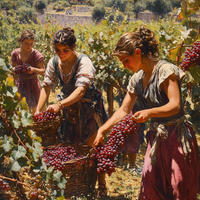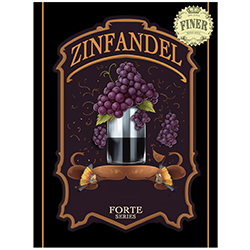The Zinfandel Grape: Unraveling the Secrets of an Enigmatic Ancient Treasure
Posted by Matteo Lahm on 22nd Nov 2024
Have you ever wondered what specifically makes the Zinfandel grape so unique and enchanting? As you embark on your winemaking journey, let us delve into the captivating world of Zinfandel, exploring the chemical compounds that contribute to its distinct flavor profile and the special fermentation techniques that can elevate your homemade Zinfandel wine to new heights.
The Zinfandel Grape: A Flavorful Enigma
The Zinfandel grape, often referred to as the "mystery grape," has a rich history and a flavor profile that can be as complex as a Shakespearean play. Its origins can be traced back to Croatia, where it is known as Crljenak Kaštelanski, and Italy, where it goes by the name Primitivo. This versatile grape can produce a wide range of wines, from light and fruity to bold and spicy, making it a favorite among winemakers and wine enthusiasts alike.
The exact age of the Zinfandel varietal grape is difficult to determine, but it is believed to be an ancient grape variety with origins dating back thousands of years in the Adriatic Sea region. Genetic studies have shown that Zinfandel is genetically identical to the Croatian grape varieties Crljenak Kaštelanski and Tribidrag, as well as the Italian grape variety Primitivo.
The earliest historical records of Zinfandel's cultivation date back to the 18th century in Croatia. However, the grape's genetic lineage suggests that it may have been cultivated in the region for much longer, possibly even dating back to the time of the ancient Greeks and Romans.
The earliest records of Zinfandel cultivation can be traced back to the 18th century in Croatia. Historical documents from the Dalmatian coast, dating back to 1798, mention the cultivation of Tribidrag, which is genetically identical to Zinfandel.
In Italy, the grape variety was known as Primitivo and was first documented in the early 19th century. In 1820, a priest named Don Francesco Filippo Indellicati identified the grape in Gioia del Colle, a small town in the Apulia region of Italy. He named it "Primitivo" due to its tendency to ripen earlier than other grape varieties in the region.
Zinfandel was introduced to the United States in the 1820s, where it gained popularity in the mid-19th century, particularly in California. The grape variety was initially imported as a table grape, but its potential for winemaking was soon recognized. By the 1850s, Zinfandel was widely planted in California, and it played a significant role in the early development of the Californian wine industry.
The Chemistry Behind the Flavor
As you savor a glass of Zinfandel, you may notice flavors of blackberry, cherry, plum, and even black pepper. These delightful flavors are the result of a symphony of chemical compounds working in harmony. Let's take a closer look at some of the key players in this flavorful ensemble:
1. Monoterpenes: These aromatic compounds are responsible for the fruity and floral notes in Zinfandel. Linalool and geraniol are two monoterpenes that contribute to the grape's enticing aroma.
2. Pyrazines: If you've ever detected a hint of black pepper in your Zinfandel, you can thank pyrazines for that. These compounds are responsible for the spicy, peppery notes that can add depth and complexity to your wine.
3. Anthocyanins: These pigments give Zinfandel its deep, rich color. They also contribute to the wine's tannin structure, which can influence the mouthfeel and aging potential of your homemade Zinfandel.
4. Esters: Produced during fermentation, esters are responsible for the fruity aromas in Zinfandel. The most common ester found in Zinfandel is ethyl hexanoate, which imparts a delightful blackberry aroma.
Unlocking the Grape's Potential: Fermentation Techniques
Now that you have a better understanding of the chemical compounds that make Zinfandel so unique, let's explore some fermentation techniques that can help you bring out the best in your grapes:
1. Cold Soaking: Refrigerating your must before fermentation can extract more color and flavor from the grape skins. This technique can result in a more intense, fruit-forward wine. Cold soaking, also known as cold maceration, is a technique used in winemaking to extract color, flavor, and aroma compounds from grape skins before fermentation. The process involves soaking crushed grapes in a temperature-controlled environment.
The maximum temperature for cold soaking grapes is generally around 50°F (10°C). Maintaining this low temperature helps to prevent the onset of fermentation and allows for a gentle extraction of the desired compounds from the grape skins. Some winemakers may opt for slightly higher temperatures, up to 55°F (13°C), but it is crucial to keep the temperature below the fermentation threshold to avoid premature fermentation and potential spoilage. The rule is colder temps equals a longer soak. If your temperatures are on the high end, your soak should not exceed 72 hours. If you can maintain a temperature in the high 30’s, you can extend the process even longer up to a week.
2. Co-Fermentation: If you're looking to add complexity to your Zinfandel, consider co-fermenting it with a small percentage of another grape variety, such as Petite Sirah or Carignan. This can create a more layered and nuanced wine. The Sonoma Finer Wine Kit is a blend of Zinfandel and Petite Sirah.
3. Oak Infusion: Aging your Zinfandel in oak barrels can impart additional flavors and aromas, such as vanilla, toast, and smoke. Be cautious, though, as too much oak can overpower the grape's natural flavors. If you are using cubes or spirals, be sure to taste your wine regularly and remove the oak when you reach the desired flavor profile. Remember that it is easy to add oak flavor but impossible to remove it, unless you can blend it with another wine that has no oak to balance it out. Read more about different oak characteristics and methods.
4. Malolactic Fermentation: This secondary fermentation process can soften the acidity of your Zinfandel, resulting in a smoother, more balanced wine. Malolactic Fermentation has a learning curve and requires some know-how with managing your equipment. You can read more about the ins and outs in a previous article about malolactic fermentation.
Conclusion:
As you continue your winemaking journey, remember that the Zinfandel grape is a versatile and complex character, with a flavor profile that can be shaped and molded by your expert touch. By understanding the chemistry behind its unique flavors and employing special fermentation techniques, you can create a Zinfandel wine that is truly a masterpiece. So, raise a glass to the enigmatic Zinfandel grape, and let your creativity flow as you craft your next homemade wine. Cheers!




